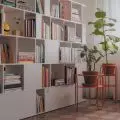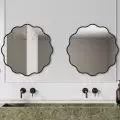A {tag:studenci} from the Faculty of Architecture at the Wrocław University of Technology has designed a Cultural Center located in the Wielkopolska village of Drzonek. The center is a response to the need, noticed by the author, to locate cultural facilities outside of large cities, blending harmoniously with the surrounding landscape. The space is intended to become a magnet for residents of nearby towns and villages and people traveling through the region, promoting its culture.
axonometry
© Malgorzata Zielonka
context
The architecture of the building, creating a mood of calm and concentration, is based on the principles of urban composition, maintaining a balance with the surroundings. The design of the Cultural Center aims to bring out and articulate the hidden context of the area. For the author, it was important to create a space in harmony with nature. The building, composed of internal micro landscapes, combined into a single form sunk into the external landscape, breaks down the boundaries separating it from its surroundings. The cubics that make up the building allude to the rock blocks in the quarry, creating a dialogue between horizontality and verticality, the lightness of glass and the weight of stone and concrete.
facades
© Malgorzata Zielonka
spirit of place
The concept of spirit of place, known since Roman times as genius loci, is central to reflections on urban planning and architecture. Christian Norberg-Schulz, an advocate of the symbiotic relationship between humans and natural space, considers genius loci to be the moral compass of modern construction. According to these considerations, the Center's design process involved an interaction between methodical design movements and leaving areas of nature untouched. Nature dictates the viewpoint of male and female viewers in the facility, which emphasizes the authenticity of the experience in the space.
cross section
© Malgorzata Zielonka
cross-section
© Malgorzata Zielonka
impact and importance of the senses
Architecture should allow users and users to calm down and open up to the world by engaging all the senses. Juhani Pallasmaa, in her book "TheEyes of the Skin, " points out theimportance of touch as the mother of all senses, reminding us that through the skin we can recognize colors. In the Center 's design, the introduction of nature into the building 's interior allows the viewer and recipient not only to see it, but also to feel and touch it.
interior visualization
© Malgorzata Zielonka
form and function
The design process of the Cultural Center was based on the idea of integrating aesthetic and functional choices. The idea was to create a space in harmony with the environment, allowing one to listen to its silence. Geometric forms and their correlations create a space full of nuance, highlighting elements of topography and exposing the complexities of various forms. Functionally, the place is flexible and can be adapted to different social groups.
interior visualization
© Malgorzata Zielonka
building as sculpture
When designing the interiors of the Cultural Center, the focus was on natural light and its filtering. The building, formed as a solid block of concrete, has cutouts in the form of windows, skylights and interior courtyards, creating a new sense of space. The architecture encourages exploration, allowing a leisurely walk through the building, during which one experiences changes in materials, light and the height of the space.









































